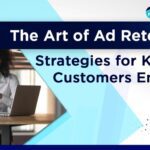The Next in Personalization report from McKinsey states that companies that successfully demonstrate customer intimacy generate faster rates of revenue growth. Furthermore, consumers today highly value a personalized marketing experience. The gains become bigger as organizations get closer to the consumer.
At every touch point throughout the marketing funnel, from the initial exposure to a brand to the post-purchase experience, advertisers should prioritise providing a personalised experience for consumers. This is precisely why personalising digital campaigns is crucial.
Continue reading to discover the definition of personalised marketing, its benefits, and how to utilise it for your programmatic campaigns.
What is Personalized Marketing
In personalised marketing, companies tailor messaging to an individual or a specific audience, and they further refine it based on the individual’s or audience’s relationship with the brand.
In the realm of digital advertising, personalised marketing utilises data such as purchase history and demographics to create ad campaigns that are highly relevant to the target audience.
The Benefits of Personalizing Your Marketing
Personalized marketing aims to create a sense of alignment between consumers and a brand by catering to their interests and values.
For instance, a retargeting campaign displaying products previously browsed by users gives them a distinct impression that those ads are specifically tailored.
So, what advantages does personalized marketing offer?
- It provides marketers with deeper insights into their customers.
- It fosters the development of customer relationships and trust.
- It drives customers to progress further down the sales funnel.
- It leads to customer retention and loyalty.
- It encourages customer engagement, and feedback, and strengthens brand affinity.
Successful implementation of strategies brings forth the following additional benefits:
Improves Customer Experience
Customers feel more at ease sharing personal information with their favourite brands when they receive something valuable in return. They willingly fill out forms, download whitepapers, participate in surveys to obtain discounts and express their favourite purchases or preferences.
However, there’s a condition: consumers expect brands to safeguard their sensitive information and provide enhanced personalized experiences upon their return.
Drives Revenue
By identifying and addressing the preferred channel for each customer targeting, companies can enhance their return on investment (ROI).
With appropriate automation technology, marketers can determine the channels through which customers engage and automatically follow up across multiple channels, adopting an omnichannel approach.
Increases Brand Loyalty
When consumers share information and data, they anticipate being treated as unique individuals with specific preferences. Businesses that allocate time and resources to effectively implement individual marketing strategies reap the rewards of competitive advantage in terms of brand loyalty and customer satisfaction.
Creates Consistency Across Channels
Consumers interact with brands across various channels such as email, social media, mobile platforms, and more, sometimes all in a single day.
Consequently, brands must establish consistency across these different channels. The in-store experience should align with the app experience, which should be consistent with email messaging. The objective is to maintain a cohesive brand experience across all touchpoints.
Tips For a Personalized Marketing Strategy
To build a personalized marketing strategy, you need to follow an ongoing process. Take note of the following 6 tips to get started:
- Utilise data to guide your strategy.
- Create comprehensive customer profiles.
- Develop creatives that effectively communicate with your ideal audience.
- Employ contextual advertising to deliver ads that are relevant to the target audience.
- Re-engage your audience by implementing dynamic retargeting techniques.
- Conduct a brand lift study to optimise your ads.
Utilise data to guide your strategy
Understanding your audience is the key to personalised marketing. Data assumes a vital role in this process as it offers valuable insights necessary to develop an accurate customer profile. Demographic data, behavioural data, website analytics, and transaction data can all be utilised to personalize your digital marketing strategy.
When sifting through the available data, it is important to consider a few factors. Firstly, review the existing data and assess its suitability for reaching your ideal audience. For instance, if your target is millennials residing in a specific area, it is essential to ensure that you possess the relevant demographic data.
Additionally, make sure to leverage up-to-date data. Outdated data may not accurately represent your customers. Secondly, ensure you have access to data throughout the entire customer journey. Understanding their journey from the beginning to the end enables you to craft ad messages that align with various touch points along the marketing funnel.
Create comprehensive customer profiles
Factual information about the demographics and buying behaviours of your target audience is provided by segmented customers profiles. These profiles encompass all the necessary details about a specific group of customers.
They hold significant importance in the creation of personalized ad campaigns, as customer profiles offer the information required to develop a digital strategy that aligns with the preferences and needs of the audience.
To construct customer profiles, begin by broadly identifying your audience and then narrowing it down to a profile that aligns with your product or offer. This can be achieved by analysing your customers’ journey and considering demographics such as age, income level, family size, occupation, education level, and marital status.
By comprehending your customers, including their preferred channels, you can determine the most effective digital ads to reach these profiles. Consequently, you will not only create campaigns that appeal to your ideal customers but also ensure that these campaigns effectively reach the intended audience.
Develop creatives that effectively communicate with your ideal audience
The creative assets for a campaign present an opportunity to engage the audience in a relatable, educational, and attention-grabbing manner. They serve as a powerful tool for establishing a connection with the audience and fostering trust.
To develop personalized and creative, the key lies in understanding your audience. Familiarise yourself with your target audience, and their preferences, and refer to past campaigns to identify what resonated with them.
Subsequently, evaluate your campaign objectives and brainstorm campaign messaging that not only serves those objectives but also aligns with your understanding of the target audience. It is important to ensure that your ad’s messaging is clear, the copy is engaging, and the ad incorporates visually captivating imagery.
In addition, leveraging creative tactics offers another means of personalizing your ad campaigns. Creative tactics enable you to set specific parameters for a drive, allowing the use of tailored creatives based on defined circumstances.
This eliminates the need to create separate campaigns for each rule. For example, you can establish parameters to display different creatives based on factors such as time of day, day of the week, device type, geographic location, and even domain.
Employ contextual advertising to deliver ads that are relevant to the target audience
Contextual advertising employs a cookieless targeting methodology that utilises content instead of user data to effectively reach the appropriate audience at the optimal moment. By focusing on content, you establish connections with consumers who are receptive to the messaging conveyed in your ad.
Unlike behavioural targeting, which identifies ideal users based on their attributes, contextual advertising adopts a different strategy. It targets users based on the content they are currently consuming.
Aligning advertisements with relevant content results in a more personalized experience for your audience. For instance, through contextual targeting, a person browsing a blog that discusses various types of coffee may encounter an ad promoting a coffee maker.
Re-engage your audience by implementing dynamic retargeting techniques
In today’s programmatic advertising landscape, users need to encounter your marketing multiple times to increase the likelihood of them completing a conversion. Retargeting campaigns serve as a valuable tool for re-engaging prospects who have already shown interest, by delivering more relevant messaging.
Whether they have viewed or clicked on your ads or explored your website, the retargeted audience consists of individuals who have demonstrated an interest in your business or products.
By repeatedly reaching out to users, the effort required to secure their conversion is slightly reduced compared to prospects who haven’t engaged with you.
Dynamic retargeting enables you to present an ad featuring a product the user has previously viewed. This personalized ad serves as a reminder to the user, encouraging further engagement and reinforcing brand recall.
Conduct a brand lift study to optimise your ads
A brand lift study provides insights into consumer sentiment and brand affinity for individuals exposed to your media across all programmatic placements.
It measures the impact of your campaigns and can be utilised to gauge the perception of your brand resulting from upper funnel campaigns, as well as to assess the impact on consideration or purchase intent for mid to lower funnel campaigns.
By leveraging a brand lift study, you can surpass traditional metrics like impressions and gain a deeper understanding of how your campaign influences consumer perceptions and behaviours.
It enables you to identify the awareness, perception, consideration, and likelihood of purchase among your target consumers. These insights empower you to evaluate the effectiveness of your campaign and optimise it to deliver a more personalized experience for your ideal consumers.
Challenges of Personalization in Marketing
Personalized marketing, like any marketing strategy, presents its own set of challenges. Let’s examine some of the most common hurdles:
Finding the Right Technology
Outdated technology that is ill-suited for the mobile era poses a significant challenge in personalized marketing. Successful personalization relies on effective data collection and automation, necessitating the use of an intelligent algorithm. However, many marketers face difficulties in finding a suitable and intelligent personalization engine that meets their requirements.
Time and Resources
While the right software is essential for personalization, companies also require a dedicated team. However, not all companies are prepared to allocate the necessary time and resources to implement a successful personalized marketing strategy.
Creating a Single Customer View
To gain a comprehensive understanding of customers, marketers need to identify common patterns across channels by consolidating customer data into a unified profile. However, research indicates that marketers encounter difficulties in linking data to individual customer profiles, hindering their ability to establish a complete picture of the customer.
Implementing Smart Segmentation
Smart segmentation across channels goes beyond surface-level presentation; it enhances performance. Unfortunately, many marketers still struggle to move beyond basic segmentation strategies. In fact, according to Adweek, 85% of brands admit that their segmentation strategy relies on broad segments and simple clustering.
Addressing these challenges requires proactive solutions and the willingness to adopt advanced technologies and segmentation techniques to unlock the full potential of personalized marketing.
Conclusion: Personalize Your Marketing Campaigns
Knowing the needs, preferences, and interests of your current and target audience is the essence of personalization. It enables you to tailor your digital campaigns to precisely deliver what they are seeking, precisely when they are seeking it.
By personalizing your digital campaigns, you provide a positive experience that captivates your audience (including potential customers), ultimately guiding them through the marketing funnel.





